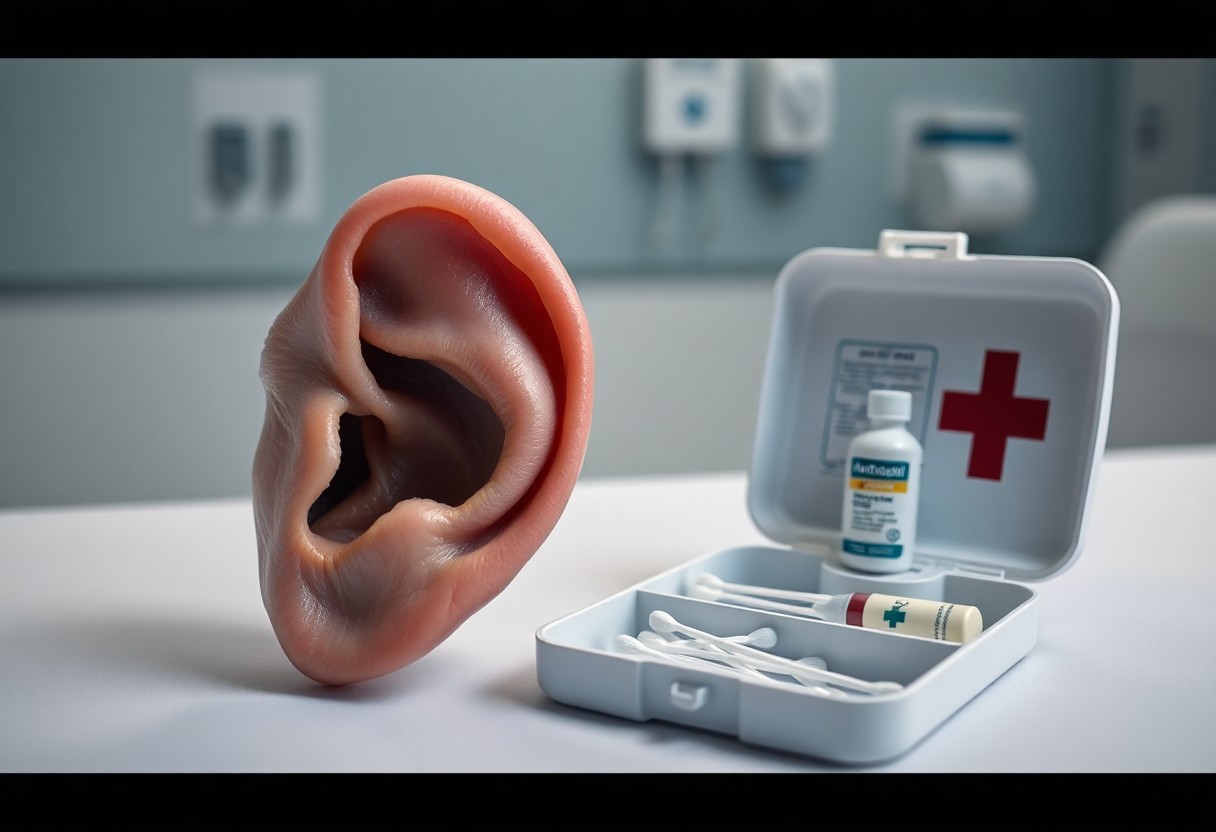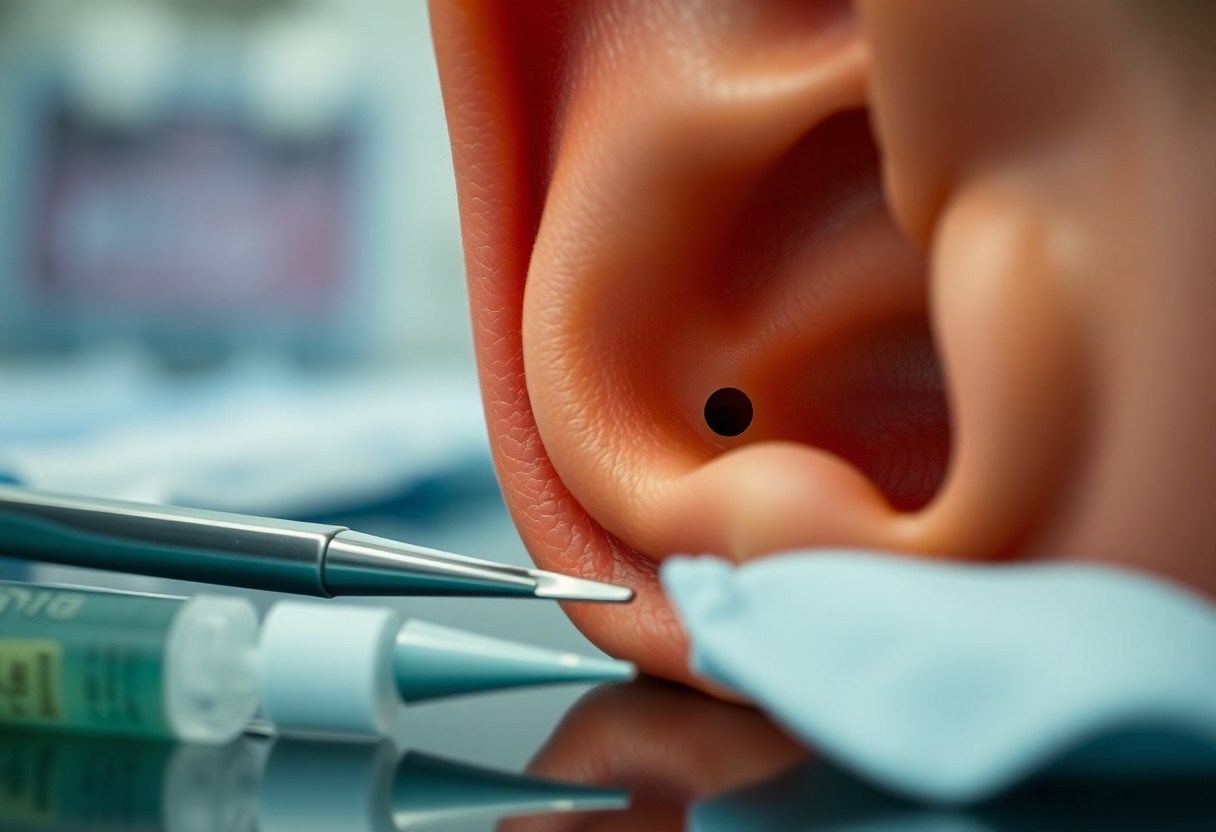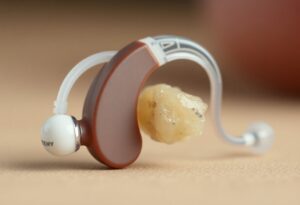Over-the-counter ear cleaning solutions may seem like a convenient option, but improper use can lead to serious complications, including perforated eardrums. If you’ve been considering DIY cleaning methods, it’s vital to understand how your actions can impact your ear health. This post will guide you through the risks associated with DIY ear cleaning, the signs of a perforated eardrum, and the best practices for safe ear care to protect your auditory well-being.

Key Takeaways:
- DIY cleaning can lead to perforated eardrums due to improper techniques and tools.
- Symptoms of a perforated eardrum include ear pain, discharge, and hearing loss.
- Seeking professional medical assistance is important for diagnosis and treatment of ear injuries.

The Anatomy of the Ear: What Makes It Vulnerable
Understanding Ear Structure and Function
Your ear consists of three main parts: the outer ear, middle ear, and inner ear, each playing a vital role in hearing. The outer ear captures sound waves, which travel through the ear canal to vibrate the eardrum in the middle ear. This vibration is then transmitted to the inner ear, where sound is converted into electrical impulses for the brain to process. The eardrum, or tympanic membrane, is a thin layer that separates external sounds from delicate inner ear structures, making it susceptible to damage from improper cleaning methods.
Identifying Areas of Risk for Injury
The Dangers of DIY Ear Cleaning Practices
Common Techniques and Their Risks
Many individuals resort to cotton swabs, ear candles, or even homemade solutions for ear cleaning. Cotton swabs often push wax deeper into the ear canal, escalating the risk of blockages and potential perforation of the eardrum. Ear candling, touted as a natural remedy, can cause burns or introduce debris into the ear. Each method carries substantial risks that can lead to severe complications, including infections and hearing loss.
Misconceptions Surrounding Ear Wax Removal
Common misconceptions about ear wax removal can lead to harmful practices. Many believe that ear wax should be completely eliminated for hygiene, but this is misleading. Ear wax serves protective functions, including lubrication and trapping dust and debris. Over-cleaning can disrupt its natural balance, causing irritation and increased wax buildup.
Believing ear wax is merely a nuisance can lead you to aggressive cleaning methods that are unnecessary and damaging. The ear canal is self-cleaning, and excessive removal can cause dryness and itchiness, prompting a vicious cycle of cleaning. It’s vital to recognize that a small amount of ear wax is normal and beneficial for ear health. Embracing this understanding can guide you towards safer practices and help preserve your hearing. Proper maintenance should focus on preventing blockage rather than complete removal of ear wax.
Signs and Symptoms of a Perforated Eardrum
Immediate Indicators to Watch For
You may notice sudden ear pain, which can vary in intensity and might be accompanied by a feeling of fullness in the ear. Discharge, often clear or bloody, may also appear, along with a noticeable reduction in your ability to hear. Additionally, you might experience ringing in the ear (tinnitus) following any cleaning attempts, signaling potential damage.
Long-term Effects and Complications
Persistent issues can arise from a perforated eardrum, including recurrent ear infections and prolonged hearing loss. In some cases, scar tissue formation can impact the ear’s ability to vibrate properly, further jeopardizing hearing. Depending on the severity, surgical repair may be necessary, adding to healthcare costs and recovery time.
Long-term complications are not uncommon if a perforated eardrum goes untreated. Repeated infections can lead to chronic otitis media, which may cause continuous discomfort and drain your energy. Hearing loss can impact daily activities, making communication challenging, and potentially affecting your social and professional life. A perforation can also increase susceptibility to other ear diseases, with the possibility that surgery could become important to restore full function and prevent further complications.
Medical Insights: Expert Perspectives on Ear Care
Insights from Audiologists and ENT Specialists
Audiologists and ENT specialists frequently emphasize the importance of professional evaluations for ear health. DIY cleaning often exacerbates problems rather than alleviating them, leading to complications such as perforated eardrums, infections, or hearing loss. Observations from experts reveal that even seemingly benign practices, like using q-tips, can push wax deeper into the ear canal, necessitating more invasive interventions. Regular check-ups are recommended to maintain optimal ear health.
Evidence-Based Recommendations for Safe Ear Hygiene
Experts advocate for safe ear hygiene practices that prioritize your ear’s natural self-cleaning mechanisms. Avoid inserting objects into the ear canal; instead, gently wipe the outer ear with a damp cloth. Use ear drops or saline solutions if you experience excessive wax build-up, and consult with a specialist for professional cleaning when necessary.
Following evidence-based recommendations can significantly reduce the risk of complications associated with ear cleaning. Regular examinations by healthcare professionals can detect earwax issues early and address them before they escalate. If earwax becomes troublesome, over-the-counter solutions like carbamide peroxide can help soften wax without needing invasive cleaning methods. These approaches not only promote ear health but also minimize your risk of injury or infection, ultimately preserving your hearing. Prioritizing professional care ensures that any underlying issues are thoroughly evaluated and managed appropriately.
Emergency Response: What to Do if You Suspect a Perforation
First Steps Following an Injury
After an injury, avoid inserting any objects into your ear to prevent further damage. Tilt your head to let any fluid drain out if you’re experiencing discharge. Keep your ear dry and avoid exposing it to water, as this could lead to infection. Applying a cold compress outside your ear can help alleviate swelling and discomfort. If pain persists, over-the-counter pain relief may be beneficial.
When to Seek Professional Medical Help
Seek medical attention if bleeding occurs, if you experience persistent pain, or if you notice pronounced dizziness or hearing loss. These symptoms may indicate complications that require professional evaluation. Additionally, any fluid discharge that is cloudy or foul-smelling warrants immediate medical care, as it may signal an infection.
In some cases, even minor symptoms can escalate, leading to more severe issues such as chronic hearing loss or ear infections. If you suspect a perforation based on your symptoms or recent ear cleaning attempts, timely intervention by a healthcare professional ensures proper diagnosis and treatment. Specialists may perform a physical examination and imaging if necessary to assess the extent of the damage and recommend appropriate care, ensuring your ear health remains intact.
Preventive Measures: Safeguarding Your Eardrums
Best Practices for Ear Hygiene
Maintaining ear hygiene involves gentle external cleaning with a soft cloth, avoiding insertion of objects like cotton swabs, and keeping ears dry after bathing or swimming. Regular check-ups with an audiologist can help identify any potential issues before they escalate. You should also refrain from using earbuds or earphones for extended periods, as these can trap moisture and create a breeding ground for bacteria.
Alternatives to DIY Cleaning Methods
Professional cleaning methods, such as ear irrigation, provide safe and effective options for earwax removal. Audiologists can assess your ear health and use tools specifically designed for this purpose, minimizing risks associated with improper techniques at home.
Ear irrigation involves a gentle stream of water to flush out wax buildup, performed in a controlled environment. Other methods include professional suctioning or the use of specialized instruments, which can remove earwax without the danger of pushing it deeper or damaging your eardrum. Seeking the advice of an audiologist ensures you’re following safe practices tailored to your individual ear health needs.
The Psychological Impact of Ear Injuries
Emotional and Social Consequences
Experiencing an ear injury, particularly a perforated eardrum, can lead to significant emotional distress. Feelings of anxiety and frustration often arise due to hearing loss or discomfort, adversely affecting your daily interactions and relationships. You may find yourself withdrawing from social situations to avoid embarrassment or the strain of communication challenges, which can exacerbate feelings of isolation.
Strategies for Coping and Rebuilding Confidence
Rebuilding confidence following an ear injury involves both psychological and practical steps. Engaging in support groups or therapy can facilitate emotional recovery. Listening to others’ experiences provides validation and connection. Simple auditory exercises, along with hearing aids or adaptive technology, can help you regain a sense of normalcy in communication. Gradual exposure to social settings, combined with positive affirmations, fosters resilience while rebuilding your self-esteem.
Effective coping strategies focus on both emotional resilience and practical adjustments. Seeking support from specialists who can guide you through the recovery process is beneficial. Gradually introducing auditory activities into your routine helps desensitize any heightened anxiety. Tracking your progress and celebrating small victories in communication can motivate you. Utilizing tools such as hearing aids can enhance your auditory experience, allowing you to engage more fully in conversations, thus reducing feelings of embarrassment and isolation over time.
To wrap up
With this in mind, it’s crucial to prioritize safety when it comes to cleaning your ears. DIY methods can often lead to unintended damage, such as perforated eardrums, which can result in pain, infection, and long-term hearing issues. Always consult a healthcare professional for appropriate ear care advice and avoid inserting objects into your ear canal. By taking these precautions, you can protect your hearing health and ensure your ears remain safe and clean.
FAQ
Q: What is a perforated eardrum?
A: A perforated eardrum is a tear or hole in the thin membrane that separates the ear canal from the middle ear. This can lead to hearing loss and increase the risk of ear infections.
Q: How can DIY cleaning lead to a perforated eardrum?
A: DIY ear cleaning methods, such as using cotton swabs or other objects, can inadvertently push debris deeper into the ear canal or injure the eardrum, resulting in a perforation.
Q: What are the symptoms of a perforated eardrum?
A: Symptoms may include sudden hearing loss, ear pain, dizziness, fluid drainage from the ear, and ringing or buzzing in the ear (tinnitus).
Q: How can I treat a perforated eardrum at home?
A: While minor perforations may heal naturally, it is important to keep the ear dry and avoid inserting anything into the ear canal. Seek medical advice for proper treatment options.
Q: When should I see a doctor for a perforated eardrum?
A: Consult a doctor if you experience severe pain, persistent bleeding, hearing loss, or signs of infection such as fever and increased drainage or odor from the ear.



